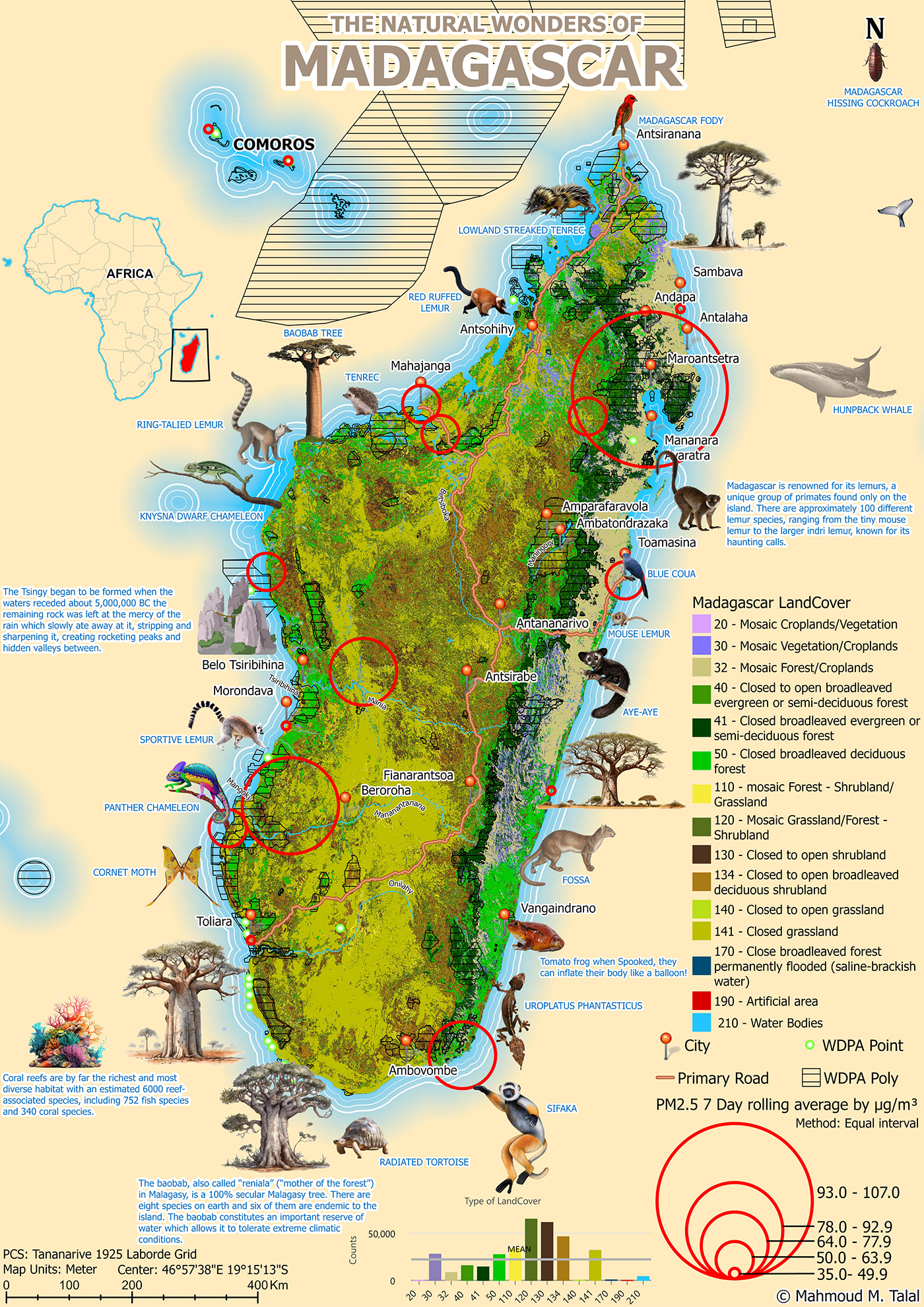In this map that I just created I tried to highlight THE NATURAL WONDERS OF MADAGASCAR
Some 90% of Madagascar's plant and animal species are found nowhere else on earth, only half of the country's high-priority biodiversity hot spots lie within protected areas.
It's often called the Eighth Continent, split from India 88 million years ago following its initial separation from Gondwana the supercontinent approximately 165 million years ago. That separation has resulted in fauna and flora found nowhere else on the planet.
it's the World’s 4th Biggest Island It measures in at a whopping 581,540 sq km making it bigger than France.
There are more than 12,000 species of exceedingly diverse plants growing in Madagascar It's sometimes referred to as the “Great Red Island” because of its iron and aluminum rich soils that produce brilliant red colors.
Some 90% of Madagascar's plant and animal species are found nowhere else on earth, only half of the country's high-priority biodiversity hot spots lie within protected areas.
It's often called the Eighth Continent, split from India 88 million years ago following its initial separation from Gondwana the supercontinent approximately 165 million years ago. That separation has resulted in fauna and flora found nowhere else on the planet.
it's the World’s 4th Biggest Island It measures in at a whopping 581,540 sq km making it bigger than France.
There are more than 12,000 species of exceedingly diverse plants growing in Madagascar It's sometimes referred to as the “Great Red Island” because of its iron and aluminum rich soils that produce brilliant red colors.

THE NATURAL WONDERS OF MADAGASCAR
I have used the following is to highlight the features of natural wonders:-
• The World Database on Protected Areas (WDPA)
Is the most comprehensive global database of marine and terrestrial protected areas, and is one of the key global biodiversity data sets being widely used by scientists, businesses, governments, international secretariats and others to inform planning, policy decisions and management.
There are monthly updates of the data which are made available online through the Protected Planet website where the data is both viewable and downloadable.
The reach of the WDPA is further enhanced in services developed by other parties, such as the Global Forest Watch and the Digital Observatory for Protected Areas, which provide decision makers with access to monitoring and alert systems that allow whole landscapes to be managed better.
• Recent Conditions in Air Quality
Every day activities such as driving, burning coal for electricity, wildfires, running factories, even cooking and cleaning, release particles into the air. Besides being an irritant, small particles of 10, 2.5, 1 micrometer (PM10, PM2.5, PM1) or less are a health hazard since they can get deep into the respiratory system and damage the delicate tissues.
The World Health Organization (WHO) guidelines provide long-term and short-term exposure limits to PM10 and PM2.5:
- Long-term: PM10 20 µg/m³ annual mean and PM2.5 10 µg/m³
- Short-term: PM10 50 µg/m³ 24-hour mean and PM2.5 25 µg/m³
Exposure to PM10 and PM2.5 above these limits may significantly impact protected areas health.
Source: The source information is the OpenAQ community which reports measured concentrations (µg/m³) and particle matter count (particles/cm³) by aggregating station data from national networks of air quality.
• The World Database on Protected Areas (WDPA)
Is the most comprehensive global database of marine and terrestrial protected areas, and is one of the key global biodiversity data sets being widely used by scientists, businesses, governments, international secretariats and others to inform planning, policy decisions and management.
There are monthly updates of the data which are made available online through the Protected Planet website where the data is both viewable and downloadable.
The reach of the WDPA is further enhanced in services developed by other parties, such as the Global Forest Watch and the Digital Observatory for Protected Areas, which provide decision makers with access to monitoring and alert systems that allow whole landscapes to be managed better.
• Recent Conditions in Air Quality
Every day activities such as driving, burning coal for electricity, wildfires, running factories, even cooking and cleaning, release particles into the air. Besides being an irritant, small particles of 10, 2.5, 1 micrometer (PM10, PM2.5, PM1) or less are a health hazard since they can get deep into the respiratory system and damage the delicate tissues.
The World Health Organization (WHO) guidelines provide long-term and short-term exposure limits to PM10 and PM2.5:
- Long-term: PM10 20 µg/m³ annual mean and PM2.5 10 µg/m³
- Short-term: PM10 50 µg/m³ 24-hour mean and PM2.5 25 µg/m³
Exposure to PM10 and PM2.5 above these limits may significantly impact protected areas health.
Source: The source information is the OpenAQ community which reports measured concentrations (µg/m³) and particle matter count (particles/cm³) by aggregating station data from national networks of air quality.
• Land cover
The types of land cover derived from the original raster based Globcover regional (Africa) archive, there are 15 classes in island and I explain the most prominent animals and plants found on it.
#gis #geography #geographicinformationsystems #map #maps #mapping #cartography #art #madagascar #wonders #layout #design #poster #arcgispro #natural


